Couldn't figure this out. Just need to enter 1 emoji into a string and couldn't figure it out. Unicode is not working. Tried diagraph but didn't work either. Is there some trick to this in Vim? thx!
-
http://junegunn.kr/2014/06/emoji-completion-in-vim/ – Kent Oct 26 '16 at 13:00
-
thanks. Was hoping for a way to just enter it without adding a whole plugin. Not that big of a deal to add a plugin just seems like there has to be another way. – Fedreg Oct 26 '16 at 13:03
5 Answers
You do not need to install a plugin for this. All you need to do is enter the unicode value of the emoji. You can do that in insert mode with <C-v>. From :h i_ctrl-v_digit:
*i_CTRL-V_digit*
With CTRL-V the decimal, octal or hexadecimal value of a character can be
entered directly. This way you can enter any character, except a line break
(<NL>, value 10). There are five ways to enter the character value:
first char mode max nr of chars max value ~
(none) decimal 3 255
o or O octal 3 377 (255)
x or X hexadecimal 2 ff (255)
u hexadecimal 4 ffff (65535)
U hexadecimal 8 7fffffff (2147483647)
For example, if you want to enter this smiley-face, which has a unicode value of U+1F60A, you could simply type:
<C-v>U1F60A<esc>
or if you don't want to hit <esc>,
<C-v>U0001F60A
Just so you know, there's a good chance that it will not render properly in vim, depending on your font. If you are using gvim, you can change :se guifont=*, or in regular vim, changing your consoles font to make it render (assuming you pick a font that can render this particular emoji)
- 7,285
- 4
- 41
- 61
-
1I succeeded entering a smiley face per your example. But I am trying to enter ❤️, which comes up with two code points, "U+2764, U+FE0F". Not sure how to enter that! – Dmitry Minkovsky Apr 08 '20 at 03:50
Another approach is to use abbreviations.
I added a few in my .vimrc file and now I just type :pushpin: for , :bulb: for , :bomb: for , etc...
" Emoji shortcuts
ab :white_check_mark: ✅
ab :warning: ⚠
ab :bulb:
ab :pushpin:
ab :bomb:
ab :pill:
ab :construction:
ab :pencil:
ab :point_right:
ab :book:
ab :link:
ab :wrench:
ab :info:
ab :telephone:
ab :email:
ab :computer:
There are a lot more of them on emojicopy.com or similar sites. I just picked a few I already used before.
- 3,514
- 15
- 37
-
1Nice; the [following answer](https://stackoverflow.com/a/57027637/211827) links specifically to [emoji-ab](https://gitlab.com/gi1242/vim-emoji-ab), and this essentially mirrors what I [utilize system-wide for replacements](https://ghcdn.webcore.io/mac/system-wide-text-replacements.png). – amcgregor Nov 22 '21 at 16:54
-
So looks like I reinvented the wheel again :-D. Thanks for the report @amcgregor – bitifet Dec 26 '21 at 22:09
While it is possible to <c-v>U1f60A<esc>, it's not practical if you're
responding to email / entering a comment in a web form. I'm not going to
memorize unicode emoji tables for quick "Thanks " comment.
Few other options for such use cases:
Type your usual smileys like
:)and have a plugin replace it with the unicode equivalent . The plugin emoji-ab does this for you.Type codes like
:boom:. Many markdown parsers will convert it to for you. But if you're not using such a parser, emoji-ab will also convert it for you.Use something like gucharmap (or one of the many online Unicode pickers) to copy and paste unicode characters into vim.
- 51
- 1
- 2
Another way to access these emojies in many contexts including Vim is to use the character map dialog window:
- On Mac, press Ctrl+Command+Space and select the character.
- On Windows, press Windows+R and type the charmap.
- 27,830
- 11
- 80
- 100
- 51
- 3
- 4
-
GNOME 3.28 and above (Ubuntu Linux and elsewhere) has an emoji picker, but sadly it doesn't work in GNOME Terminal. See https://www.omgubuntu.co.uk/2018/06/use-emoji-linux-ubuntu-apps – Flimm Dec 31 '20 at 16:31
You can use emoji-fzf pip package
First install fzf
sudo apt install fzf
then intall emoji-fzf
pip install emoji-fzf
now make sure you can run emoji-fzf
emoji-fzf --help
if you get "comand not found" error please see pip installs packages successfully, but executables not found from command line
now add emoji-fzf to your .vimrc
" Use emoji-fzf and fzf to fuzzy-search for emoji, and insert the result
function! InsertEmoji(emoji)
let @a = system('cut -d " " -f 1 | emoji-fzf get', a:emoji)
normal! "agP
endfunction
command! -bang Emoj
\ call fzf#run({
\ 'source': 'emoji-fzf preview',
\ 'options': '--preview ''emoji-fzf get --name {1}''',
\ 'sink': function('InsertEmoji')
\ })
" Ctrl-e in normal and insert mode will open the emoji picker.
" Unfortunately doesn't bring you back to insert mode
map <C-e> :Emoj<CR>
imap <C-e> <C-o><C-e>
restart your vim and press ctrl + e and search for your favourite emoji and press enter
- 1,486
- 2
- 18
- 21
